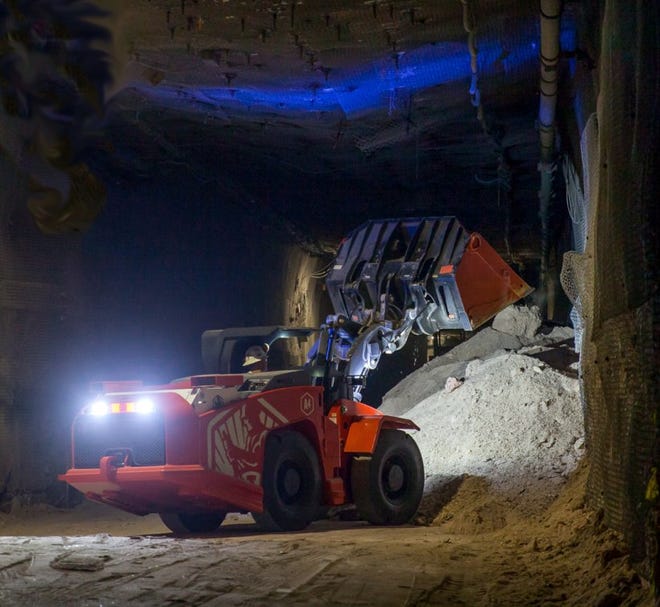
An effort to replace diesel vehicles and equipment at the Waste Isolation Pilot Plant with electrical and battery-operated components is underway, part of a broader goal of improving airflow in the underground nuclear waste repository.
Available air in the underground, where low-level nuclear was is permanently disposed of, became restricted following an accidental radiological release in 2014 that contaminated parts of the mine.
WIPP officials took steps in the years following the event, beginning work on new utility shaft, planning to restart a major ventilation fan and moving forward with a multi-million-dollar rebuild of the facilities ventilation system known as the Safety Significant Confinement Ventilation System (SSCVS).
More:Amid legal battles over WIPP air system rebuild, new contract awarded to finish the work
When complete, the SSCVS will provide 540,000 cubic feet per minute (cfm) of breathable air to underground workers, but it the latest estimate showed it won’t be ready until 2025.
In the meantime, Chair of the Carlsbad Mayor’s Nuclear Task Force John Heaton said multiple projects needed to be completed for workforce safety related to airflow including converting all the vehicles used in the underground to electric.
“The main importance of it is worker safety. Running diesel creates many toxic fumes in the enclosed area,” Heaton said. “There’s a big major effort to go to all electrically run equipment so that there’s no diesel.”
More:WIPP: Restart of ventilation fan needed for worker safety at nuclear repository
The underground fleet at WIPP includes 80 vehicles, with 37 identified as essential to WIPP operations, read report from the U.S. Department of Energy.
To replace or convert all 37, officials estimated it would take about five years, the report read.
Older diesel engines were retrofitted with newer engines with less nitrogen dioxide emissions, scheduled to replace those on five of its salt-haul vehicles by the end of June.
More:DOE planning to increase down-blended plutonium shipments to Waste Isolation Pilot Plant
The site is also evaluating battery-electric vehicles that would operate with zero emissions, but also must fit in small areas of the underground.
That equipment can range from small forklifts to large-haul vehicles and electrifying them would require additional areas of the repository mined to hold charging stations.
A battery-powered load haul dump was used in the mine for the past two years, the report read, and was shown to be able to operate in tight spaces with more torque than similar diesel machines.
More:‘Sparking’ nuclear waste drum at Los Alamos National Lab leads to evacuation at WIPP
And after WIPP staff visited a mine in Elko, Nevada that used battery-power vehicles, the report read, such equipment was deemed suitable for WIPP and three units were ordered for delivery in the next three months.
If those units meet expectations, another six will be ordered.
WIPP Mining Manager Dave Sjomeling said the machines use work platforms that can be interchanged based on needs, while a dump bed is being designed for WIPP and other units can be configured for equipment such as a lift platform or fuel distributor.
More:WIPP: Hearing planned for new utility shaft amid fears it could extend nuke waste disposal
“The units are ‘plug-and-play,’ meaning you drive the vehicle up to a receptacle and plug it in to charge. No changing of batteries is needed until the end-of-service life,” Sjomeling said.
Reducing diesel equipment in the underground would also lessen the amount of such fuel needed to be stored, Heaton said, cutting down on risks like fires or environmental contamination.
“There’s a significant amount of diesel fuel that has to be held underground in storage for vehicles that are still diesel. That represents a risk itself,” he said. “They’ve moved very quickly in purchasing the low emission vehicles. They want to replace everything underground and make it all run on electricity.”
More:Waste Isolation Pilot Plant aims to expand underground facility to hold nuclear waste
Another project aimed at reducing emissions at WIPP involved capturing carbon dioxide from oil and gas operations, separating hydrogen that can then be converted into a fuel cell to provide electrical power to the underground, Heaton said.
He said the Task Force is working with DOE and WIPP to study such a project with Albuquerque-based Bayotech.
“We’re very interested in working with the oil and gas industry and DOE to put a project like that together,” Heaton said. “It benefits a lot of parties.”
Airflow improvement at WIPP was important, Heaton said, to allow continued operations in mining, waste emplacement and maintenance.
“It’s a very restrictive space. Today, we have very limited air supply. The emissions from diesel are rather toxic in nature in terms of nitrous oxide and other ingredients,” Heaton said. “When you’ve got low airflow, there’s no flushing that out of the mine.”
Adrian Hedden can be reached at 575-618-7631, achedden@currentargus.com or @AdrianHedden on Twitter.






